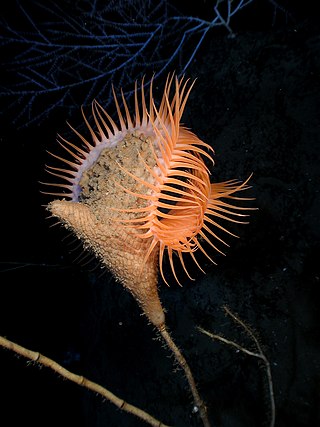
Tube-dwelling anemones or ceriantharians look very similar to sea anemones but belong to an entirely different class of anthozoans. They are solitary, living buried in soft sediments. Tube anemones live inside and can withdraw into tubes, which are composed of a fibrous material made from secreted mucus and threads of nematocyst-like organelles known as ptychocysts. Within the tubes of these ceriantharians, more than one polyp is present, which is an exceptional trait because species that create tube systems usually contain only one polyp per tube. Ceriantharians were formerly classified in the taxon Ceriantipatharia along with the black corals but have since been moved to their own class, Ceriantharia.

Actinoscyphiidae is a family of sea anemones.

Rhodactis is genus of mushroom corals which are characterized by large individual polyps that are often reminiscent of a mushroom. Rhodactis are related to stony corals but do not produce a stony skeleton.

Nemanthus annamensis, commonly known as the gorgonian wrapper, is a species of sea anemone found in central Indo-Pacific waters.

Hormathiidae is a family of sea anemones in the class Anthozoa.

Epiactis is a genus of sea anemones in the family Actiniidae. There are about nineteen recognised species and the type species is Epiactis prolifera.

Metridium farcimen is a species of sea anemone in the family Metridiidae. It is commonly known as the giant plumose anemone or white-plumed anemone. It is found in the eastern Pacific Ocean from Alaska down to Catalina Island, California.

Haliclystidae is a family of stalked jellyfish in the order Stauromedusae.
Actinernoidea is a superfamily of sea anemones in the order Actiniaria, Until 2014, this taxon was considered to be a separate suborder of the order Actiniaria.

Diadumene is a genus of sea anemones. It is the only genus in the monotypic family Diadumenidae.

Edwardsiella is a genus of sea anemones in the family Edwardsiidae. It is named in honour of Henri Milne-Edwards, an eminent French zoologist.
Paranemonia is a genus of sea anemones that consists of two species; both of which are endemic to the Mediterranean Sea:

Bolocera is a genus of sea anemone in the family Actiniidae.
Isotealia is a genus of sea anemones in the family Actiniidae.
Actinernidae is a family of sea anemones. It contains the following genera and species:
Acontiophorum is a genus of sea anemones of the family Acontiophoridae.
Epiparactis is a genus of sea anemones of the family Actinoscyphiidae. It currently includes only one species.
Anthosactis is a genus of cnidarians belonging to the family Actinostolidae.
Cadetactis is a monotypic genus of cnidarians belonging to the family Condylanthidae. The only species is Cadetactis elongata.
Stylobates is a genus of cnidarians belonging to the family Actiniidae.










